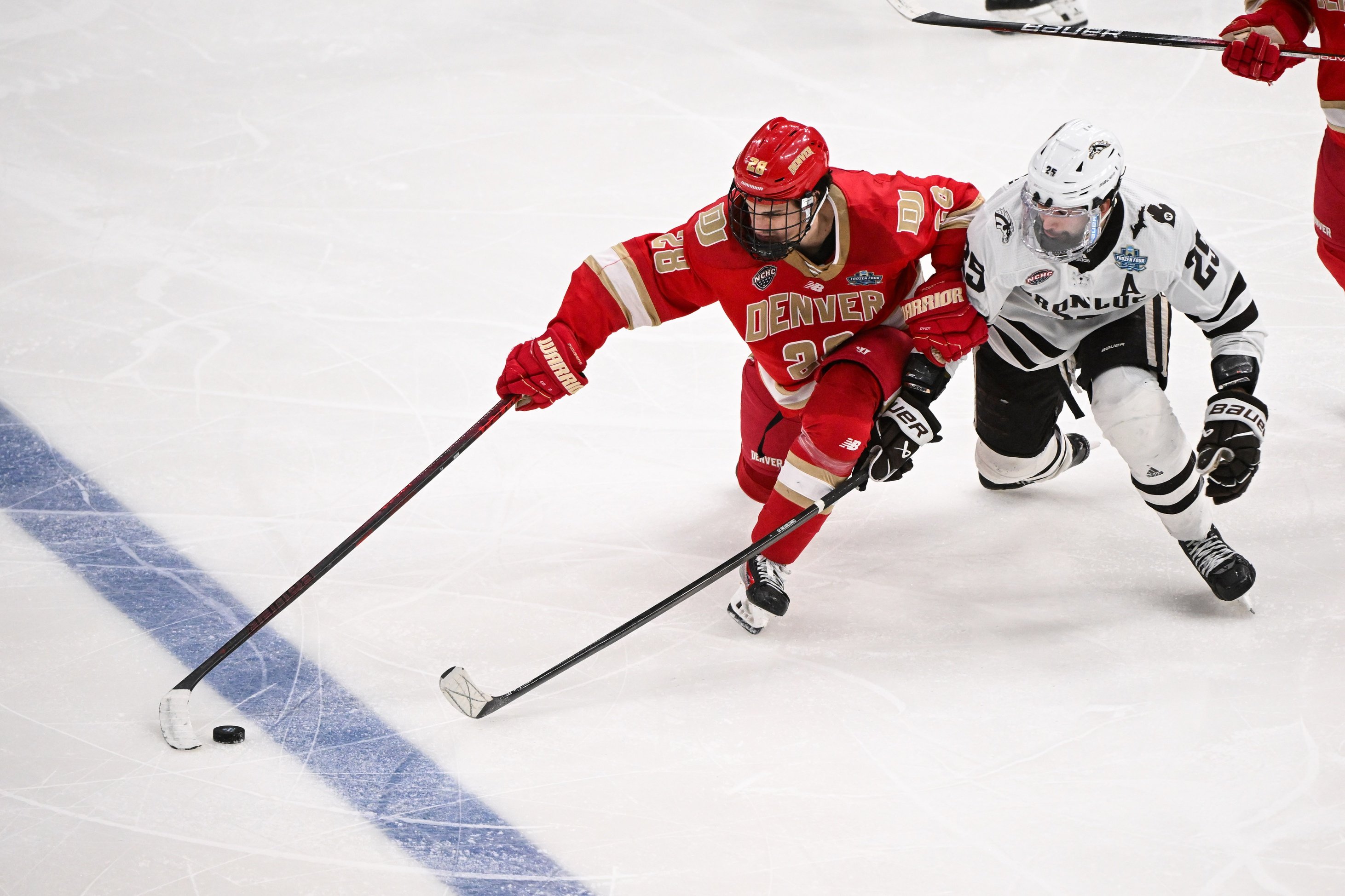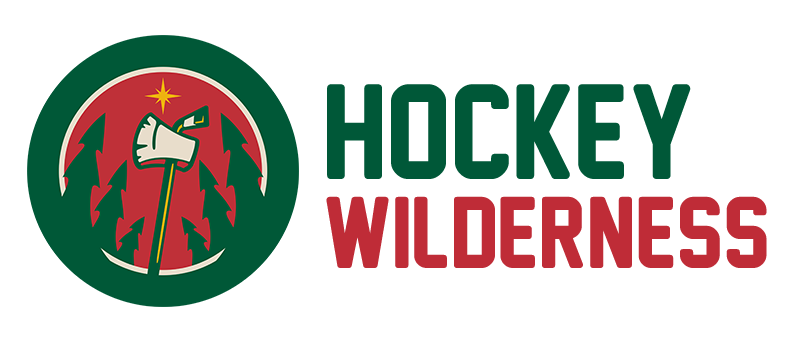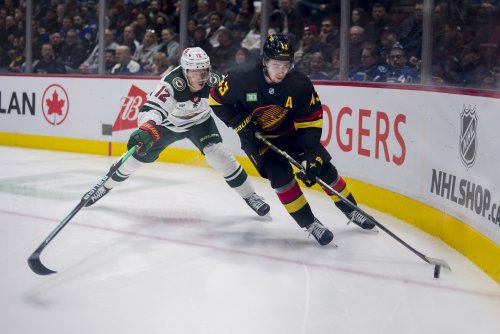
Let’s immediately get something out of the way: Zeev Buium is an NHL-caliber defenseman right now, at this moment. And after a remarkable run as an amateur that included a gold medal at the World Under-18 championships, back-to-back golds at the World Junior Championships, an NCAA championship in a season he began as a 17-year-old freshman, back-to-back seasons as the top scoring defenseman in college hockey and a Hobey Baker nomination, he’ll get a chance to prove it.
Buium made it official on Friday night when he announced his intention to leave Denver University to sign with the Minnesota Wild and begin his professional career. It sounds like he’ll join the team sometime in the coming days and make his NHL debut on Tuesday at the Xcel Energy Center in the Wild’s season finale against the Anaheim Ducks.
There has been plenty of hype around the teen phenom ever since the Wild selected him with the 12th overall pick in the 2024 draft, and his resume suggests that the hype has been justified.
But how does his game stack up to the NHL, and what should Wild fans expect from him this season? Is he ready to be a contributor right away in the playoffs, and if so, how might the Wild use him?
Let’s dig into his game a bit:
Offense
To start, it’s worth noting that for almost every game Buium has played for the past two seasons – and possibly even longer – he’s been the best player on the ice, often by a wide margin. When a player exists within that norm, it’s impossible not to develop some habits that reflect a player used to doing whatever he wants, and that’s occasionally been the case for Buium.
He has frequently been guilty of holding onto the puck too long at the offensive blue line, attempting to deke and dance around opponents until he gets the perfect opportunity to slice into the heart of the defense and make a play. Of course, Buium wouldn’t have developed that habit if he couldn’t get away with it, and more often than not at the college level, he did.
If he wants to succeed immediately at the professional level, he’ll have to dial it back a bit and learn to make a safe pass to an outlet or a pass along the boards down low to continue a forecheck.
That said, there’s no mistaking the singular offensive abilities that Buium will bring to the Wild blue line. When he’s on the ice, his team usually has the puck, and he’s often the one with it.
His skills are such that he’ll be able to create offense on his own immediately. Buium’s ability to combine body fakes and deception with elite skating to create opportunities for himself and teammates is basically a hybrid of Quinn Hughes and prime-era Adam Fox, two of the most offensively gifted defensemen to come to the NHL from the college ranks in recent years.
Buium can beat defenders one-on-one at the blue line or when moving down the wall. While he’ll have some adjustments to make to learn to make quick decisions with the puck when defenders close in on him, his high-end puck skills are good enough to beat NHL defenders right now.
He can create shooting lanes, and while he doesn’t have a blistering shot, he can get it off quickly and with high accuracy. This includes snap shots and wrist shots to beat goalies clean, aiming for a teammate’s stick to get a deflection, or just getting shots through with traffic in front.
These same attributes will immediately make him a dangerous power-play asset. He will step into the NHL and instantly be a high-end power-play quarterback.
Buium is so good at creating lanes and using any open ice to his advantage that it might take his new Wild teammates some time to learn how to best read off his constant movement and precise, cutting attacks. He loves working two-man give-and-goes and orchestrating plays to open up a teammate and hit him with an accurate, well-paced pass.
He's also a one-man breakout in a way that reminds me of Jonas Brodin, except his puck skills are better. Buium’s offensive instincts allow him to turn a loose puck or turnover into instant offense the other way. This is another skill that will translate as soon as he arrives in St. Paul.
The main thing he’ll have to rein in is the tendency to look for the perfect play and hold onto the puck until he finds it. Like other elements of his game in college, this developed from being a dominant player. If Buium can rein that in and rely on his ability to make crisp, well-timed, accurate passes, he can be a reliable puck mover in his own end.
Defense
This area of Buium’s game raises the most questions about his ability to contribute immediately in the playoffs. How will the young defenseman withstand the rigors of defending high-speed attacks, withstanding physical forechecks, and winning puck battles against the best players in the world?
Buium's effectiveness as a defender depends on skating, footwork, and body positioning, and he’ll also have to rely on those attributes in the NHL.
Similar to the offensive side of the puck, Buium has grown accustomed to being dominant and sometimes is too dependent on his skating, particularly when defending the rush. He’s overly reliant on his ability to recover and sometimes takes bad or sloppy lines, giving opposing attackers more ice than he should. NHL forwards will be able to exploit this extra ice, so he’ll need to be more diligent with his gaps in pro hockey.
Still, Buium knows how to defend with his feet and should be adequate in most situations as long as he remains diligent with his positioning. He has superb hockey sense and can read plays, recognize attacks, and disrupt them before they become dangerous. Like Victor Hedman, he often defends the rush by turning and skating forward rather than backward.
Footwork and positioning are also his biggest assets in board battles. In the NHL, he’ll be able to hold his own in these situations if he can get to the spot first, or at the right time, and establish good positioning. His strong legs and balance will be able to fend off opposing players so he can emerge with the puck or push it to a teammate.
However, as you’d expect with a teenager in a men’s league, Buium will struggle initially if it comes down to a pure strength battle for a puck. That’s okay, but it could be an issue in heavy matchups.
The biggest weakness in Buium’s defensive game is his off-puck positioning and awareness, which is the biggest cause for concern regarding his ability to immediately translate his game to the NHL.
For example, when the puck is in the neutral zone, and either team hasn’t established possession or is changing hands back and forth, Buium can be guilty of puck-watching and drifting out of position into bad spots, sometimes even to his defensive partner’s side of the ice. If the opposition gets possession and starts a quick attack, he often has to scramble to recover or attack the rush from a bad place, and his partner gets hung out to dry or has to try and read off Buium's scrambles.
The same goes for instances when the opposition establishes long forechecks and pressure. Buium tends to try to read plays and anticipate where the puck might go, which he often does well. However, he drifts out of positioning to do this, and if he makes the wrong read or the puck takes a bounce, he’s not where he should be.
In college hockey, there aren’t enough pure scorers that can capitalize on these instances, but that won’t be the case in the NHL. It’s easy to envision scenarios where Buium tries to jump a play that doesn’t happen, and a forward gets left alone in the slot or on the back door.
It’s less-than-ideal, for sure, and will cause some growing pains in the NHL, where predictability and positioning are the backbone of defensive structures that rely on cohesion to succeed. It’s not something to be overly concerned about long-term. Buium is an intelligent player who will adapt to the NHL with experience. However, initially, it will cause Wild coaches and fans the occasional headache and goal against.
Intangibles
In the 2025 World Juniors, perhaps the most impressive part of Buium’s performance – besides the world-class pass to spring Teddy Stiga for a breakaway on the game-winning overtime goal in the gold medal game (the last highlight in the video below) – was how calm Buium was throughout the entire tournament.
That version of Team USA had plenty of dynamic players playing high-octane offense. Buium produced in that department with two goals and four assists in seven games. He also played a steady, quiet game for much of the tournament. He made smooth breakout passes, calmly skating the puck out of trouble and driving the USA offense from the back end while maintaining defensive positioning in ways he didn’t need to do for a well-structured Denver team this season.
It’s telling that, in the highlight package below, you’ll mostly see Buium making smart, efficient plays with the puck and less of the dynamic, jaw-dropping plays that populate his other highlight reels.
If he can bring some of that quietness to the NHL, his transition will be more seamless.
From a physical standpoint, Buium has shown that he isn’t intimidated by heavy play. As the undisputed star of his team in college, Buium was targeted every night by opposing teams. Still, he consistently showed a willingness to engage and stand up for himself.
Boston College made a point of targeting him in the NCAA tournament this year. The Eagles took runs at him all game, and Buium and Ryan Leonard (now with the Washington Capitals) engaged in numerous heated net-front battles and post-whistle scrums. Buium held his own against the larger forward. He also made sure Boston College heard about it, waving goodbye to the entire opposing bench after clinching the game with an empty net goal late in the third.
What to expect from Buium this season
The bottom line is that Buium is ready to be an NHL contributor right now. As colleague Justin Wiggins stated yesterday, the Wild would be wise to use him in some capacity immediately.
Can Buium play in the NHL playoffs this season and be effective? From an offensive standpoint, he absolutely can. He’ll be the best offensive threat on the Wild blue line right away.
Will he make mistakes that lead to goals against? Probably, yes. He’s young and prone to make the careless errors young players make, and that NHL players can take advantage of.
Can he defend well enough to be a positive asset? I think he can, yes. His skating and hockey sense are good enough to compensate for some of his other deficiencies. Plus, if Buium is on the ice and the Wild have the puck more often than not, they won’t have to worry about defending.
Should the Wild give him playoff minutes? My answer is a resounding yes. Buium can be enough of an offensive asset right away to be a difference-maker if the Wild deploy him in sheltered minutes, on the power play, in offensive zone faceoffs, and in favorable matchups.
Will the Wild give him playoff minutes? That’s another question entirely. My sense is that they won’t, not right away. Coaches want predictability, and for all their faults, John Merrill and Zach Bogosian won’t get out of position in ways that Buium might. Buium’s volatility factor might be something John Hynes and his staff prefer to do without, at least initially. If anything, I could see Buium slotting in over Declan Chisholm instead of Bogosian or Merrill.
Ultimately, they should insert him into the lineup, even as a seventh defenseman. Buium is young, and it’s not easy to be an NHL defenseman, especially in the playoffs. But the Wild don’t have another player like him, and they’ll need to generate more offense than they have in previous playoff appearances if they want to make any type of run this year.
Zeev Buium might be the extra piece they need to make it happen.
Think you could write a story like this? Hockey Wilderness wants you to develop your voice, find an audience, and we'll pay you to do it. Just fill out this form.
-
 4
4
-
 2
2









Recommended Comments
Join the conversation
You can post now and register later. If you have an account, sign in now to post with your account.
Note: Your post will require moderator approval before it will be visible.